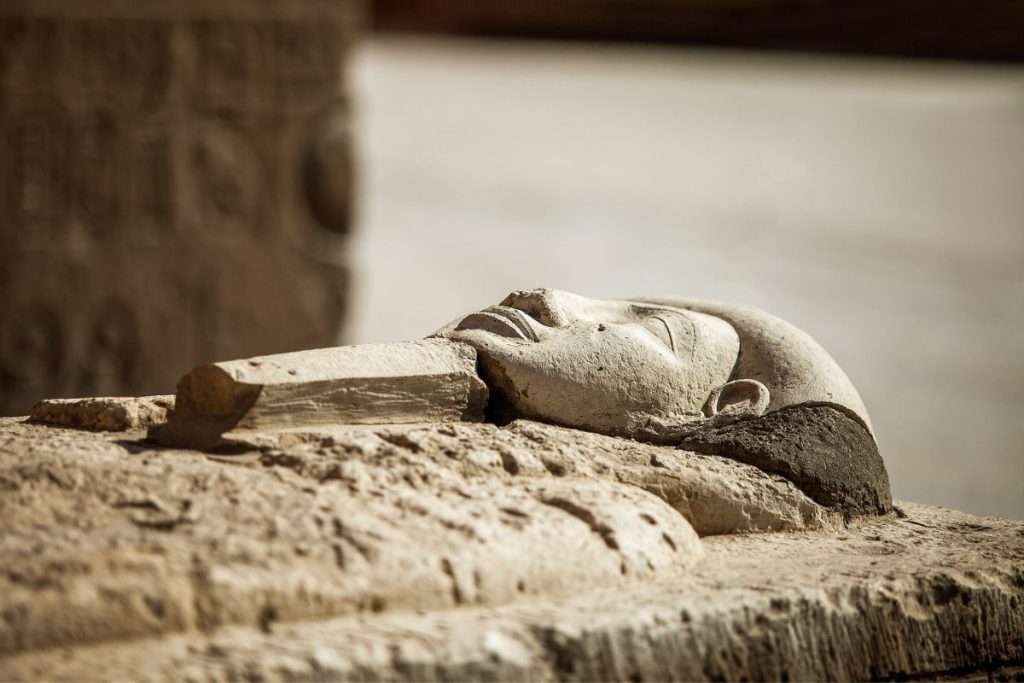Introduction
古代エジプトの黄金時代とも称される時代に足を踏み入れ、芸術、文学、建築が繁栄し、強力なファラオたちの目の下で文明が発展した瞬間を想像してみてください。これが中王国のファラオの時代であり、エジプトの歴史の中で重要な章で、文明に消えることのない足跡を残しました。紀元前2050年から1710年にかけてのこの時代は、エジプトの栄光を取り戻しただけでなく、未来の偉大さを築くための基盤を作り上げました。この魅力的な時代を旅しながら、ファラオの命令の響きと彼らの創造物の美しさが時を超えて今なお響き渡っていることを感じてください。
1. 中王国のファラオの概要
中王国はしばしばエジプトのルネサンス時代と呼ばれ、古王国の壮大さと新王国の帝国的な力の間を繋ぐ時代でした。この時代は、第一次中間期の混乱を経て、エジプトが再統一され、再生した時期でした。エジプトが混乱し、権力が分断され、内部で争いが繰り広げられていた時を想像してみてください。ここに登場するのがメンチュホテプ2世、エジプトを再統一するという大きな課題に立ち向かったファラオです。彼の指導の下で、エジプトは新しい時代の幕開けを迎え、中央集権的な力が確立され、秩序が回復されました。
歴史的背景
中王国のファラオたちは、上エジプトと下エジプトの再統一から始まりました。これは第一次中間期の分権と混乱の後の重要な節目であり、政治的な再統一だけでなく、古代エジプトの「マアト」(真実、バランス、宇宙の秩序)の復活を象徴するものでした。中王国のファラオたちは、マアトの守護者と見なされ、この神聖な義務を担って調和と安定を維持する責任がありました。
ファラオの役割
中王国のファラオたちは、中央集権的な権力を再確立する上で重要な役割を果たしました。彼らは単なる支配者ではなく、神々の地上の化身、つまり半神として崇められていました。この時代には、ファラオの意志が国全体に行き渡るようにするための複雑な官僚制度が確立されました。彼らの指導力により、エジプトの文化、経済、社会構造におけるルネサンスが実現したのです。
中王国のさらに深い探求においては、その最も著名なファラオたちの生涯と遺産を探り、彼らの治世と人類史における偉大な文明の発展に対する永続的な貢献を明らかにしていきます。
2. 中王国の著名なファラオたち
中王国では、時代を超えて評価されるような多くの優れたファラオたちが登場し、彼らの治世は後世にわたって語り継がれる功績を残しました。これらの指導者たちは、単なる支配者にとどまらず、エジプトを変革し、安定、繁栄、そして文化的な豊かさをもたらしたビジョナリーでした。この時代の最も注目すべきファラオたちに迫ってみましょう。
メンチュホテプ2世:再統一の者
分裂したエジプトが混乱と断片化の中にあり、古代エジプトの栄光を取り戻すべくリーダーを待ち望んでいる様子を想像してみてください。メンチュホテプ2世はその呼びかけに応えました。紀元前2050年ごろに即位した彼は、エジプトを再統一するという壮大な使命を果たし、これが中王国の始まりを告げる出来事となりました。軍事的な手腕と戦略的な同盟により、メンチュホテプ2世は第一次中間期の争いを終結させました。彼の治世は、50年以上にわたり安定と成長の象徴でした。彼の最も永続的な遺産は、彼の建築的野心を示すデイル・エル・バハリの墓地複合施設であり、彼が起こした文化的なルネサンスの証です。
アメネムハト1世: 王朝の創設者
メンチュホテプ2世の後を継いで、アメネムハト1世はエジプト第12王朝を創設し、古代エジプト史の中でも最も繁栄した時期の一つを築きました。権力を集約するだけでなく、共同統治制度を導入したリーダーを想像してみてください。これは、支配するファラオが選ばれた後継者と権力を分かち合い、円滑な政権移行を確保するシステムです。この革新は安定と継続性をもたらし、エジプトが繁栄するための基盤を提供しました。アメネムハト1世は、首都をイテジャワイに移し、その正確な場所は未だに謎ですが、彼の行政の中央集権化を象徴していました。彼の治世は、広範な建設プロジェクトとエジプトの国境を強化するための取り組みの始まりを示しています。
セヌスレト3世: 戦士のファラオ
セヌスレト3世は、厳しく決意に満ちた顔を持つ姿で描かれることが多く、戦士のファラオを体現しています。彼の治世は、エジプトの影響力を広げ、国境を守るための一連の軍事遠征によって特徴づけられました。ヌビアへの軍事遠征が非常に効果的で、ナイル沿いに要塞を築き、エジプトがこの重要な地域を支配することを確保しました。セヌスレト3世は軍事戦略家であるだけでなく、行政改革者でもあり、権力をさらに中央集権化し、国家の効率を向上させました。彼の遺産には、ダフシュールのセヌスレト3世のピラミッドや、彼の力強い存在を反映した数多くの彫像が含まれています。
アメネムハト3世: 繁栄をもたらした建設者
アメネムハト3世の治世の下、エジプトは経済的繁栄と建築の成果を新たな高みへと導きました。豊かな収穫と賑やかな貿易で繁栄する王国を想像してみてください。アメネムハト3世はエジプトの資源を最大限に活用し、ファユームオアシスの拡張や、後にヘロドトスが「ピラミッドよりも壮大だ」と述べたハワラの迷宮の建設など、大規模な建設プロジェクトを実施しました。彼の治世では、エジプトの急成長する人口を支えるための農業インフラが整備され、隣接地域との貿易が促進されました。
3. 成果と貢献
中王国のファラオたちは、優れた支配者であり戦士であるだけでなく、芸術、文学、建築のパトロンとしても知られています。彼らの貢献は、エジプトの文化的・知的遺産の基盤を築きました。
建築
中王国では建築の革新が見られ、ピラミッド建設の進化が起こりました。古王国の巨大で滑らかな側面のピラミッドから、より複雑で精緻なデザインへと変化していったことを想像してみてください。セヌスレト3世のピラミッドはその優れた例で、建築技術の進歩と芸術的装飾が見られます。神殿や要塞も景観に点在し、ファラオたちが石と芸術を用いて永遠の遺産を残そうとする欲求を反映しています。
文学
文学の分野では、中王国は黄金時代と考えられることが多いです。ここでは、書かれた言葉が栄え、「シヌヘ物語」のような冒険、忠誠、そして人間の経験を融合させた時代を想像してみてください。この時代には、知恵の教訓や実生活のための道徳的・実践的な指針を提供する書物も編纂されました。中王国で花開いた文学は、後の世代に基準を示し、エジプトの文化的タペストリーを豊かにしました。
芸術と文化
中王国の芸術的成果は、古王国の伝統の復興と新しい革新を融合させたものです。ファラオたちの権威と神聖な存在を、比類のないリアリズムと詳細で捉えた彫像やレリーフを想像してみてください。この時期の彫刻、絵画、宝飾製作の進歩は、エジプトの職人たちの技術と創造力を際立たせました。これらの文化的成果は、神殿や墓を飾るだけでなく、ファラオの神々との繋がりを象徴するものとして機能しました。
行政
中王国では行政の重要な進展が見られました。資源と正義を効率的に管理するための複雑な官僚制度が確立された、よく組織された国家を想像してみてください。新しい行政手法として、詳細な記録管理や地方の知事がファラオに直接報告するシステムの導入がありました。これらの改革は中央権力を強化し、エジプトの安定と繁栄に貢献しました。
4. 中王国の遺産
中王国の影響はその時代を超えて広がり、エジプトの未来を形作り、後世の世代によって記憶され、尊敬される永続的な遺産を残しました。
文化的遺産
中王国のファラオたちの業績は、新王国の基盤を築き、しばしば古代エジプト文明の頂点と見なされる時代に繋がります。この時代の文化的および知的な進展は、エジプトの後の王朝だけでなく、隣接する文明にも影響を与えました。芸術、文学、建築に対する中王国の強調は、後のファラオたちが模範とする卓越性の基準を設定しました。
歴史的記録
中王国の業績が刻まれた碑文や記録は、この重要な時代に対する貴重な洞察を提供します。ファラオたちの治世、軍事遠征、建設プロジェクトなどの詳細な記録が石に刻まれ、後世に伝えられています。これらの記録は、現代の歴史家や考古学者が中王国の歴史を再構築し、その貢献を評価するのに役立ちました。
継続性と変化
中王国から第二中間期への移行では、政治的混乱の中でも文化的および行政的な慣習が継続して見られます。中王国で学ばれた教訓や導入された革新は、エジプト社会に引き続き影響を与え、この素晴らしい時代の遺産が時代を超えて生き続けました。
結論
結論として、中王国は古代エジプトのファラオたちの強靭さ、創造性、そしてビジョンの証です。メンチュホテプ2世の再統一努力から、アメネムハト3世の建築的輝きまで、この時代はエジプトの歴史を形作り、後世にわたって人々を魅了し、インスピレーションを与え続けています。中王国の芸術、文学、建築、行政への貢献は、エジプトのかつての栄光を復活させただけでなく、その未来の偉大さの基盤を築きました。この重要な時代の豊かな歴史を探求することで、中王国のファラオたちの永続的な業績と、世界に与えた深い影響をさらに深く理解することができます。






